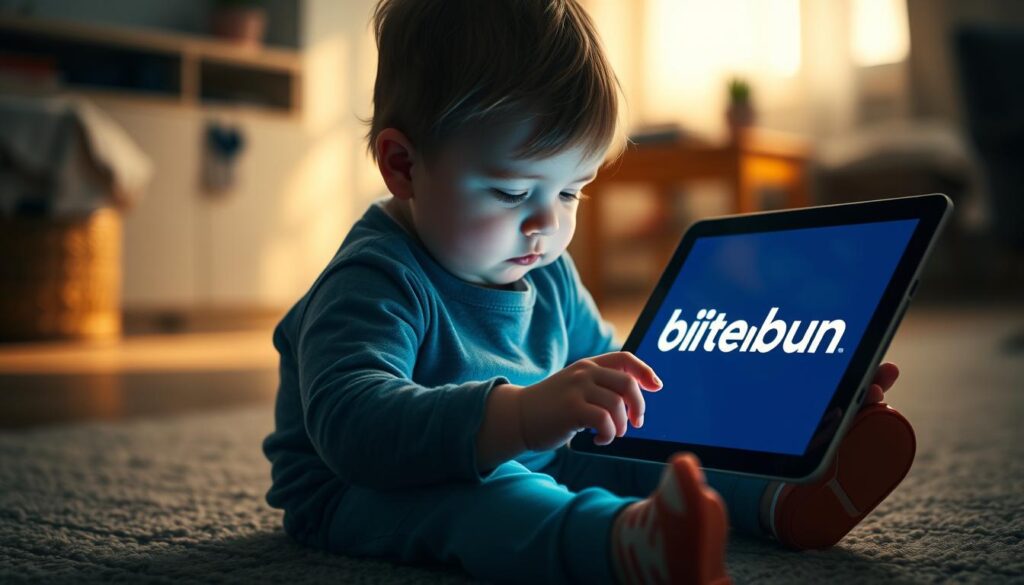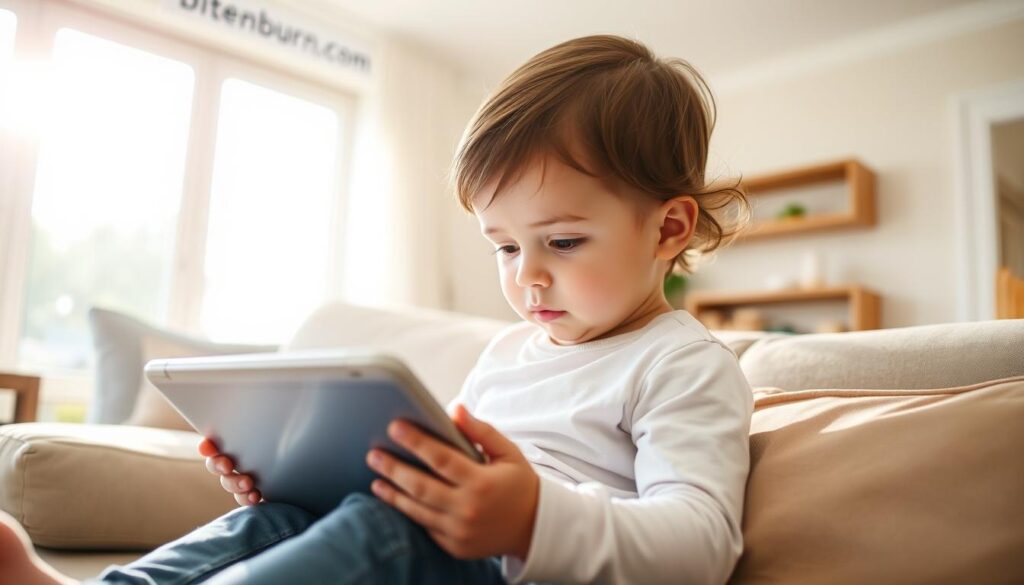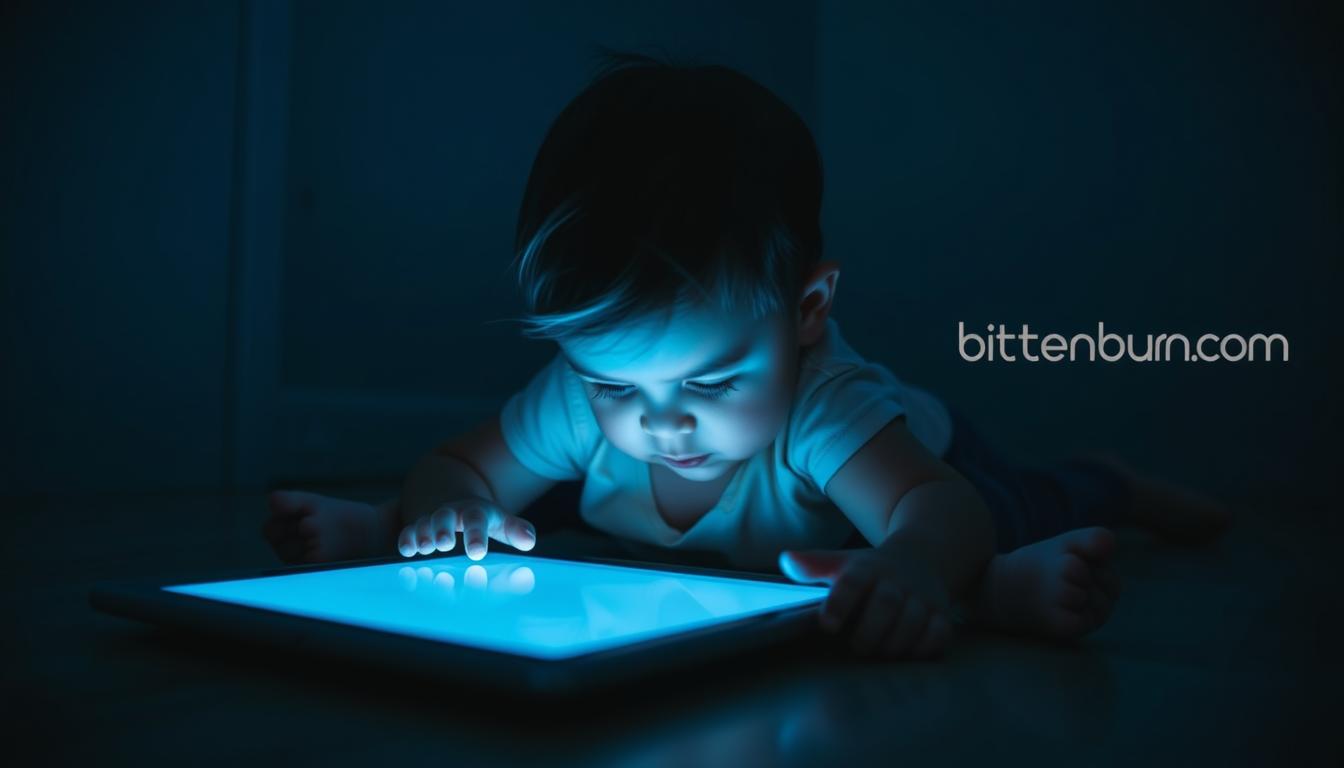“How screen time affects toddler behaviour is an important topic every parent should understand. Excessive screen exposure can influence a child’s language development, attention span, emotional regulation, and even social skills. By recognizing these effects early, parents can take steps to set healthy boundaries and encourage balanced growth.”
Did you know children now interact with digital devices as early as four months old? In 1970, the average age was four years. This 48-fold shift in early media exposure has reshaped childhood development—and not always for the better.
We’re witnessing a paradox. Tablets and smartphones offer educational tools once unimaginable, yet studies link excessive device use to delays in language growth and social skills. During these critical early years, a child’s brain forms over one million neural connections every second—making environmental influences particularly potent.
This guide unpacks the latest research on how digital habits shape young minds. We’ll explore why pediatricians urge caution with devices before age two and share practical strategies for balancing tech’s benefits with its risks. From meltdown triggers to attention patterns, every swipe and click leaves a mark.
Key Takeaways
- Children now encounter screens 12x sooner than they did 50 years ago
- Early device exposure may affect language development and emotional regulation
- Pediatric guidelines recommend zero screen use before 18-24 months
- Interactive apps differ from passive video watching in their effects
- Consistent routines reduce tech-related behavioral issues
- Parental screen habits directly influence toddler device use
Understanding the Digital Landscape in Toddlers’ Lives
The digital environment surrounding young children has undergone seismic shifts since the 1970s. Where families once gathered around living room televisions, today’s infants encounter glowing rectangles before they can crawl. This transformation carries profound implications for early development.
From Analog to Digital Dominance
In 1970, most children first encountered media around four years old. Now, University of Washington research reveals 40% of three-month-olds regularly watch TV. This 48-fold decrease in first-exposure age creates new developmental challenges.
Quantifying Screen Engagement
Current patterns show staggering device use across years:
- 8-10 year-olds average six daily hours
- 11-14 year-olds reach nine hours
- 15-18 year-olds log 7.5 hours
Canadian data paints a similar picture – nearly all children encounter screens by age two. Yet only 15% of preschoolers meet the one-hour daily limit. Mobile devices and streaming platforms have created an always-available media buffet.
“We’ve moved from scheduled programming to endless content loops. This constant availability changes how young minds process information.”
YouTube now accounts for 35% of preschooler viewing time according to CDC analyses. Tablets and smartphones dominate waking hours, creating exposure levels that demand thoughtful parental strategies.
Deep Dive: Impact of Screen Time on Toddler Behavior

Digital devices shape young minds in unexpected ways. Research reveals excessive screen time creates a dual-edged sword – educational apps may boost problem-solving skills, while passive viewing often disrupts focus. A 2023 UCLA study found children under three with high device use showed 23% more emotional outbursts than peers with limited access.
Neuroscientists identify critical concerns. Extended screen engagement alters dopamine responses, potentially rewiring reward systems in developing brains. This neural shift correlates with:
| Content Type | Potential Benefits | Possible Risks |
|---|---|---|
| Educational Apps | Pattern recognition | Reduced creativity |
| Passive Videos | Vocabulary exposure | Attention fragmentation |
| Interactive Games | Motor skill development | Impulse control issues |
Pediatric data shows behavioral challenges spike when daily use exceeds 90 minutes. Toddlers lose 12 minutes of creative play for every 30 minutes of screen time – a troubling trade-off. Structured routines with device-free zones help maintain balance.
Emerging evidence suggests content curation matters most. Co-viewed, age-appropriate material fosters better outcomes than unsupervised scrolling. As one child psychologist notes: “Screens aren’t inherently harmful – it’s how we use them that defines their influence.”
Cognitive Development Effects
Digital tools now shape how young minds grow. Interactive apps and e-books offer new learning paths, but research reveals complex effects on developing brains. Striking this balance requires understanding both potential gains and hidden costs.
Positive Learning Opportunities
High-quality educational media can boost early skills when used strategically. A 2022 Stanford study found interactive reading apps improved letter recognition by 34% in preschoolers compared to traditional methods. Electronic books with guided narration also enhance vocabulary retention through repeated exposure.
Key benefits emerge when:
- Content matches children’s developmental stage
- Parents actively discuss on-screen activities
- Sessions remain brief (15-20 minutes)
Risks to Executive Function
Excessive screen time disrupts critical neural pathways. The Quebec Longitudinal Study tracked 2,000 children, finding those with early TV exposure showed 7% lower math scores years later. Heavy device use correlates with:
- Reduced problem-solving flexibility
- Impaired working memory capacity
- Difficulty switching between tasks
Neuroscientists attribute these challenges to attention fragmentation from rapid scene changes. The American Academy of Pediatrics suggests structured media plans to protect developing cognitive skills while leveraging tech’s benefits.
Language and Communication Development

Language blossoms through human connection, not pixels. Toddlers need face-to-face exchanges to grasp vocabulary and sentence structure. When devices dominate waking hours, these vital interactions shrink.
The Power of Shared Engagement
Research reveals a striking pattern: children with high solo screen time hear 500 fewer daily words than peers. This gap directly affects speech milestones. Yet when parents actively discuss on-screen content, language scores jump 22%.
Co-viewing transforms passive watching into learning moments. The American Speech-Language-Hearing Association recommends:
- Narrating actions during educational shows
- Pausing videos to ask questions
- Connecting stories to real-life experiences
Background television proves particularly harmful. Constant noise reduces meaningful exchanges by 75% in some households. “Screens shouldn’t replace conversation starters,” notes Dr. Ellen Grant from Boston Children’s Hospital.
Content quality matters. Studies show:
| Media Type | Language Benefit |
|---|---|
| Interactive eBooks | +18% word retention |
| Fast-paced cartoons | -14% comprehension |
Families balancing tech with talk-time see best results. Setting daily limits under 60 minutes preserves crucial interaction windows. Remember – devices supplement, but never substitute, human connection.
Social-Emotional Consequences

Early screen exposure reshapes how toddlers process emotions. Research shows digital interactions often replace crucial face-to-face moments needed for healthy social growth. These changes appear in unexpected ways – from playground conflicts to bedtime struggles.
Behavioral Challenges and Emotional Regulation
Studies reveal troubling patterns. Children with over 90 minutes of daily device use show 40% more tantrums than peers with limited access. This stems from disrupted emotional processing – screens provide instant rewards but teach poor frustration tolerance.
Key findings from recent research:
| Age Group | Screen Time | Behavioral Outcome |
|---|---|---|
| 6-18 months | 1+ hours/day | 23% higher aggression rates |
| 2-3 years | 2+ hours/day | 18% lower empathy scores |
| 4 years | 3+ hours/day | 31% more anxiety symptoms |
Neuroscientists link these issues to delayed emotional understanding. Four-year-olds with high device use struggle to identify basic emotions in others. This gap persists through elementary school, affecting peer relationships.
Mental health risks emerge early. A 2024 Johns Hopkins study found preschoolers with excessive screen time showed depression markers at triple the rate of low-use peers. Sleep disruptions and reduced physical activity amplify these effects.
“Screens teach children to react, not regulate. Every minute spent swiping replaces practice with real-world emotional problem-solving.”
Practical solutions exist. Structured tech-free periods help rebuild emotional resilience. Combining device limits with role-playing games creates safe spaces for social skill development. The goal: balance digital exposure with human connection.
Physical Health Considerations

Modern toddlers face a hidden health crisis tied to glowing screens. Recent Canadian data reveals only 15% of 3-4 year-olds meet both physical activity and device use guidelines. These children spend 60% of waking hours sedentary, with screens claiming two daily hours that could fuel growth.
Movement Matters
Active play builds more than muscles. For every hour spent swiping, preschoolers lose 12 minutes practicing essential skills like throwing and jumping. Research shows excessive device use correlates with:
| Motor Skill | High Screen Users | Low Screen Users |
|---|---|---|
| Manual Dexterity | 23% slower | 41% faster |
| Balance Tasks | 17 errors/minute | 9 errors/minute |
| Object Control | 34% mastery | 58% mastery |
Nighttime brings new challenges. Blue light from devices suppresses melatonin by 37% in young children, delaying sleep onset. One study found toddlers with evening screen exposure took 45% longer to fall asleep than peers reading physical books.
“Screens don’t just steal playtime – they disrupt the biological rhythms governing growth and immunity.”
Emerging concerns include vision changes. Children under five with >2 daily screen hours show 28% higher myopia rates. Outdoor play remains critical – sunlight exposure helps develop healthy eyes while burning energy screens can’t replace.
Screen Time and Mental Health
Emerging research reveals a troubling pattern linking device use to mental health challenges in young children. A 2024 study found preschoolers with prolonged screen exposure show 3x higher anxiety markers than peers with balanced tech habits. These symptoms often manifest as clinginess, sleep disturbances, or emotional outbursts.
Activity-Specific Effects
Not all digital engagement carries equal risks. Interactive games trigger 28% stronger dopamine responses than passive videos, creating cycles of reward-seeking behavior. Nighttime device use compounds issues, suppressing melatonin production by 37% and worsening mood regulation.
Practical strategies help mitigate these effects:
- Establish tech-free zones during meals and bedtime
- Use co-viewing to discuss emotional content
- Replace evening screen time with calming routines
Recent data shows structured limits reduce anxiety symptoms by 42% in children under four. “The goal isn’t elimination,” notes child psychologist Dr. Rachel Harper, “but creating intentional tech habits that support developing minds.” Prioritizing hands-on play and face-to-face interaction builds resilience against digital stressors.


[…] reveal predictable schedules lower cortisol levels in children by up to 40%. This isn’t just about sticking to bedtimes. Regular mealtimes, play sessions, and even repeated […]
[…] we explore the connection between disciplined behaviour and longevity, it becomes clear that certain practices can significantly impact our biological age. […]
[…] Save time with effective meal prep and planning strategies. […]